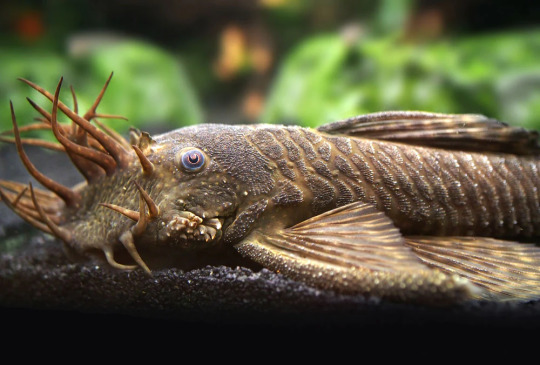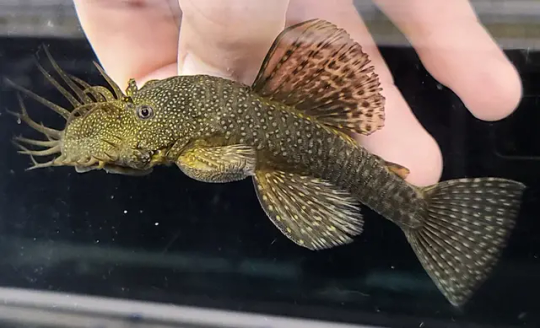#bushynose pleco
Explore tagged Tumblr posts
Text
Feeding blanched cucumber to Finnley the BN pleco and my SAE yum yum~
#aquablr#fishblr#petblr#bristlenose pleco#bushynose pleco#ancistrus#catfish#planted aquarium#aquarium#freshwater aquarium#fish#tropical fish
336 notes
·
View notes
Text
Every day he snorflin'
3K notes
·
View notes
Text
Pleco Showcase 3
1 note
·
View note
Note
Have you done bristlenose pleco facts?
I have not! Let's change that.
Daily fish fact #589
Bristlenose pleco!

Also called a bushynose pleco. They're named after their facial fleshy tentacles! Adult males will have tentacles all over their face, but females only tend to have them on their snout. They're common in aquariums due to their peaceful nature.
#fish#fishfact#fish facts#fishblr#biology#zoology#bristlenose pleco#catfish#asks#anon#anonymous#anonymous asks
248 notes
·
View notes
Text






Ancistrus cirrhosus, more commonly known as the bushynose Pleco, the bristlenose Pleco, or the the Jumbie teta, is a species of armored sucker mouth catfish of the genus ancistrus which is native to the Paraná River basin of Argentina and Uruguay. Here they tend to inhabit rivers and wetlands preferring areas with flowing water, as a typically nocturnal species they speed there days resting in crevaces and holes or under rocks and drift wood before emerging after dusk to feed upon algae, aquatic plants, detritus, carrion, and the occasional tiny invertebrate. Reaching around 3 to 6 inches in length, bristlenose plecos possess a body covered in bony plates and a ventral suckermouth. The feature most commonly associated with the genus are the fleshy tentacles found on the head in adult males; females may possess tentacles along the snout margin but they are smaller and they lack tentacles on the head. These fish are typically brown, green, or gray in coloration, with white or yellow spots and lighter and darker splotches on various parts of their bodies. Additionally albino individuals are surprisingly common. Breeding takes place in hollows, caves and mud holes in banks. Males may clean the inside of the cavity with their suckermouth before allowing the female to approach and inspect the nest, if she approves the female may lay 20–200 adhesive eggs, usually to the ceiling of the cavity. After which the female plays no role in parental care; leaving the male to care for and guard the eggs until they hatch in 4–10 days. After hatching the male will guard the young for 7 to 10 days until they set off on there own. And a male bristlenose may care for several clutches of young simultaneously. Under ideal conditions a bristlenose Pleco may live up to 12 years.
#pleistocene#pleistocene pride#pliestocene pride#pliestocene#cenozoic#fish#bristlenose pleco#pleco#plecostomus
1 note
·
View note
Text

One of my guppies died yesterday (likely of old age), and I found my bristlenose pleco eating his body. Can’t believe the internet taught me to fear my carnivorous angelfish’s tank behavior when my “algae eating” pleco is the true horror. Fish are honestly savage and I don’t think I’ll ever look at him the same way again lol. Pic above from last water change when he refused to move out of my way
73 notes
·
View notes
Text
Got a schools of Peppermint Tetras last night and they’re setting in well so far! They’re super active and add some nice contrasting color to the tank. Plus I think the angelfish needed some dither fish because they’ve stopped hiding in the corners as much.


They also had some pretty mystery snails in at the shop so I couldn’t not get one! 😅
#fishblr#fish tank#fishkeeping#freshwater tank#planted tank#angelfish#bushynose pleco#cory catfish#tetras#mystery snail
52 notes
·
View notes
Text





⭐️ new friends alert ⭐️
I picked up some blue diamond shrimp and a baby super red bristlenose yesterday!! They seem to be acclimating well and I hope they like their new home because I love them already
#I am grateful for my new orange friend#pleco my beloved#fishblr#aquablr#freshwater#my fish#freshwater tank#20gal#shrimpblr#shrimp#bristlenose pleco#plecostomus#bushynose pleco
15 notes
·
View notes
Text
Finnley nomming on a cucumber~
#aquablr#fishblr#petblr#bristlenose pleco#bushynose pleco#ancistrus#pleco#catfish#planted aquarium#aquarium#freshwater aquarium#fish#tropical fish
76 notes
·
View notes
Text
Enrichment... I maybe weighed the wiffle ball down too much. Sandy showing off her upside down tricks!



229 notes
·
View notes
Text

Solid gold , very squishy ❤
15 notes
·
View notes
Text
A SMALL BOY

51 notes
·
View notes
Text


First post!!! Hello fishblr!
I'm super excited because a pair of Ancistrus sp. layed eggs at work and a few babies made it to this size (1/4 inch)! I got to snag em and bring them home to my 10 gal walstad tank for them to grow out (will be moved once large enough). They're so tiny I don't see too much of them but sometimes they will venture onto the glass to eat. This tank has so much algae as it is newly set up so they have a nice buffet. I'll start experimenting with veggies as they get a little bigger too!
I've never raised bn plecos from this small before so any tips are appreciated!!
#fishblr#aquarium#pleco#plecostomus#fish#fish keeping#aquablr#bushynose pleco#bristlenose pleco#ancistrus
3 notes
·
View notes
Text
No!!!! The algae wafers are for the catfish!!! Don’t be greedy!!!
#fishblr#fishkeeping#fish tank#freshwater tank#planted tank#angelfish#electric blue acara#peppered cory#bushynose pleco
40 notes
·
View notes
Text
Look at Finnley's beautiful face while he munches on an algae wafer~
#aquablr#fishblr#petblr#bristlenose pleco#bushynose pleco#ancistrus#catfish#planted aquarium#freshwater aquarium
78 notes
·
View notes
Text


Like mother like daughter... Sandy and Dotty share the goofy gene
167 notes
·
View notes